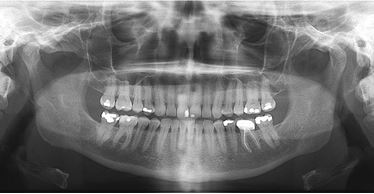RADIOGRAPHIC ASSESSMENT OF THE COURSE AND VISIBILITY OF THE MANDIBULAR CANAL BY PANORAMIC RADIOGRAPHY
Keywords:
Inferior Alveolar, Mandible, Nerve, Panoramic, RadiographyAbstract
Background and Objectives: The mandibular canal is a canal inside the mandible that contains the inferior alveolar artery, the inferior alveolar nerve and the inferior alveolar vein. The anatomy and variations of the human mandible are very important for planning various surgical measures such as extraction of the third molar, dental implants and mandibular reconstruction. This study was conducted to determine the frequency of the different courses of the mandibular canal and to investigate the visibility of the mandibular canal by panoramic radiography, among a sample of Yemeni adults.
Subjects and Methods: A retrospective cross-sectional study was conducted in Sana'a city on a sample of Yemeni adults. The study consisted of panoramic radiographs of 928 patients; the number of males was 340 (36.6%) and 588 females (63.4%). The mandibular canal course, as shown in the panoramic radiographs, was classified into four types: elliptical, linear, turning curves and spoon-shaped. The visibility of this canal from the first to the third molar region was assessed through visual determination of whether the lower canal was clearly visible, possibly visible, or invisible.
Results: Elliptical curves were the most observed along the mandibular canal course at 62.2% of the total, followed by the linear curve (24.8%) while the lower rate curve spoon (7.9%) and the turning curve (5.2%). There were no statistically considerable differences between the distribution of the mandibular canal courses between males and females except in the spoon curve where the ratio was 10.8% in males versus 6.1% in females (p <0.05). The percentage of clearly visible mandibular canals was the highest among the spoon-shaped curves (49.9% in the first molar, 63% in the second, 78.1% in the third molar) and the lowest among the linear curves (10.9% in the first, 18.7% in the second and 33.5% in the third molar). On panoramic radiographs, the invisible mandibular canals are found in 198 (21.3%) of the examined sites in the first molar region, in 85 (11%) in the second molar region, and in only 6 (0.64%) in the third molar region.
Conclusion: It was observed that elliptical curves along the path of the mandibular canal were the most present, while a decrease in the ratio of the two types of spoon curve and turning curve was observed. It was found that spoon curve was significantly more common among males than females. It was also found that the visibility of madibular canal is fewer in the first molar region than in the third molar region.

Peer Review History:
Received: 4 August 2020; Revised: 11 September; Accepted: 25 October; Available online: 15 November 2020
Academic Editor: Dr. Sally A. El-Zahaby , Pharos University in Alexandria, Egypt, sally.elzahaby@yahoo.com
, Pharos University in Alexandria, Egypt, sally.elzahaby@yahoo.com
Reviewer(s) detail:
Dr. Sunita Singh , Baylor College of Medicine, Houston, Texas, USA, sunita.nccs@gmail.com
, Baylor College of Medicine, Houston, Texas, USA, sunita.nccs@gmail.com
Dr. Ali Abdullah A. Al-Mehdar, Thamar University, Yemen, alialmehdar2006@yahoo.com
Downloads

Published
How to Cite
Issue
Section

This work is licensed under a Creative Commons Attribution-NonCommercial 4.0 International License.









 .
.